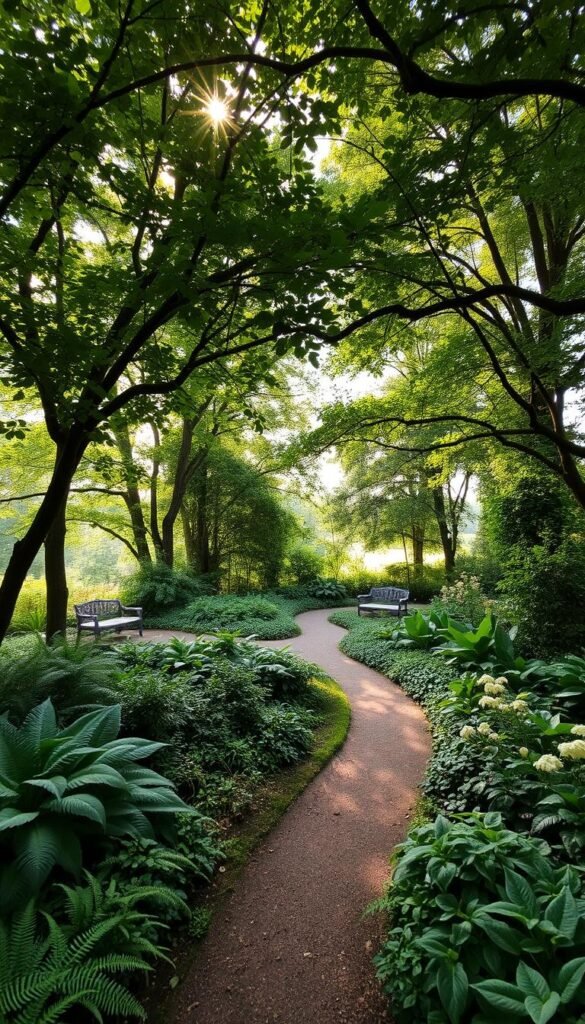Have you ever wondered what to do with those dim corners of your yard? Transforming shady spots into vibrant, inviting spaces is easier than you think. With the right approach, these areas can become peaceful escapes that thrive in lower light. Landscape experts agree: working with your environment—not against it—unlocks unique beauty.
Japanese forest grass, for example, adds golden hues and graceful movement year-round. As designer Tish Treherne notes, its winter copper tones create striking visual interest. While challenges like slower drainage exist, professional gardener Janet Loughrey emphasizes how intentional planning turns limitations into creative opportunities.
You’ll discover how foliage textures and subtle color palettes craft sophisticated outdoor rooms. Think velvety hostas paired with feathery ferns, or variegated leaves that catch stray sunlight. These combinations build layered compositions that stay captivating through seasons.
Balancing greenery with paths or seating areas creates functional retreats. Imagine sipping morning coffee surrounded by rustling leaves, or unwinding after work in your personal sanctuary. By blending natural elements with smart layouts, your space becomes both practical and magical.
Understanding Your Shade Garden Environment
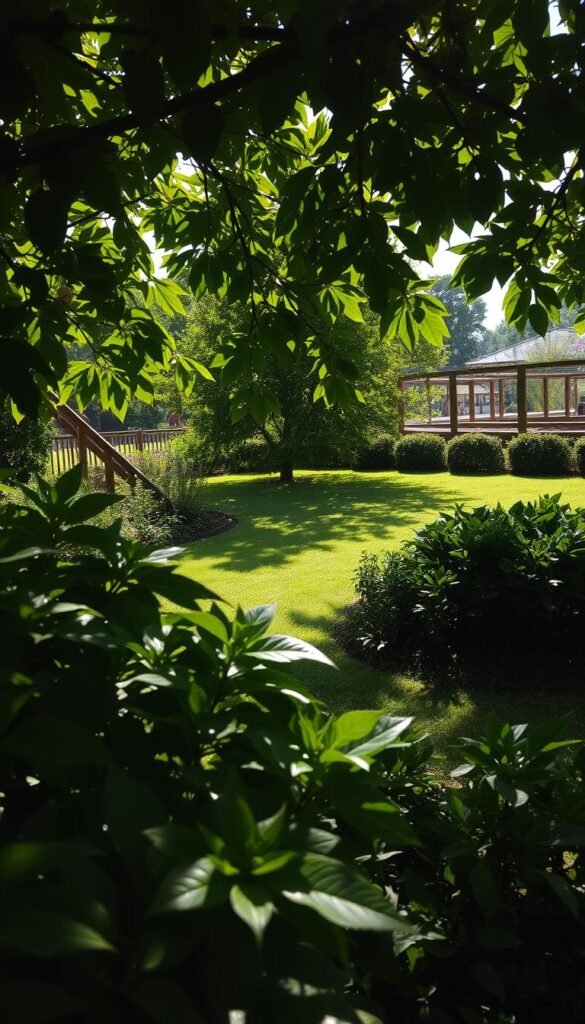
Light patterns shape every corner of your outdoor space. To cultivate thriving greenery, start by decoding your unique combination of light, moisture, and terrain. This knowledge becomes your roadmap for choosing plants that’ll flourish naturally.
Types of Shade and Light Conditions
Partial shade areas get 2-6 hours of direct sun daily. Morning light near east-facing walls nurtures delicate foliage better than harsh afternoon rays. West-facing spots often need tougher plants that handle heat spikes.
Full shade zones receive less than 2 hours of direct sunlight. These spaces under roof overhangs or between buildings demand plants that thrive in low-light conditions. Mosses and certain ferns excel here.
Beneath tree canopies, dappled shade creates ever-changing light patterns. Maple trees offer more filtered light than dense evergreens. Watch how sunlight shifts through seasons – deciduous trees grant extra winter brightness.
Assessing Soil, Moisture, and Microclimates
Damp earth stays cooler in shadowy spots. Test drainage by digging a 6-inch hole and timing how fast water disappears. Clay-heavy soil might need compost amendments to prevent root rot.
Microclimates surprise many gardeners. A north-facing slope near a heat-reflecting wall could support sun-loving plants unexpectedly. Track temperature variations with simple weather apps or soil thermometers.
Seasonal changes matter too. Spring bulbs bloom under bare trees before leaves block sunlight. Plan for these transitions to maintain year-round interest in your evolving space.
Planning Your Garden Design Layout
Mapping out your outdoor area begins with a simple pencil sketch. Grab graph paper and outline existing trees, slopes, or structures. This visual blueprint helps you see opportunities – like where a curved path could guide visitors or how a bench might nestle beneath mature branches.
Sketching Your Vision and Integrating Features
Professional landscapers often start with bubble diagrams. Draw circles representing plant groups and rectangles for built elements. A water feature near seating creates soothing ambiance, while stepping stones prevent soil compaction. Scale matters – dwarf Japanese maples suit tight spaces better than spreading hydrangeas.
For larger projects, consult a landscape design expert. They’ll help avoid costly mistakes like overcrowding or poor drainage solutions. Mix textures using feathery astilbes beside broad-leafed hellebores, ensuring each plant has room to reach mature size.
Balancing Natural Elements and Hardscape
Stone pathways should complement – not compete with – your greenery. Use local materials that match your home’s exterior. A flagstone patio surrounded by creeping thyme feels cohesive in cottage settings, while sleek concrete pairs with minimalist architecture.
Discover gardening aesthetic tips to blend function and beauty. Add vertical interest with trellised climbing hydrangeas or stacked stone walls. Leave breathing room between plantings and structures so your space evolves gracefully over seasons.
Shade Garden Design Layout: Selecting Plants and Creating Hidden Retreats
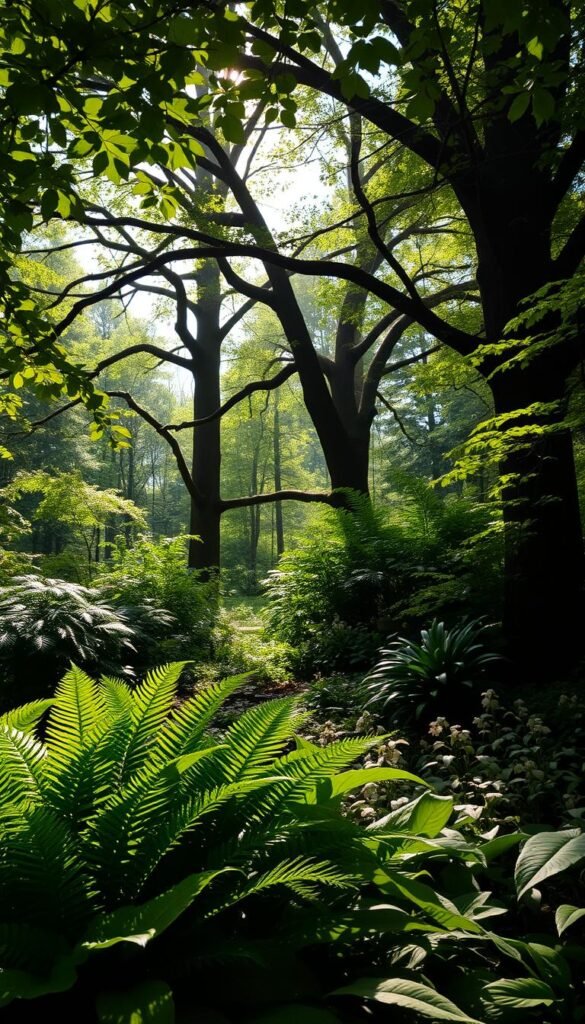
Transform shadowy areas into vibrant displays using nature’s paintbrush – foliage. Smart plant choices turn challenging spaces into textured wonderlands that evolve through seasons.
Choosing Texture and Color Champions
Leaf structure becomes your secret weapon in dim spaces. Pair feathery Jurassic T-Rex Wood Fern (Zones 5-8) with bold Sagae Hosta leaves (Zones 4-8). Their contrasting shapes catch available light differently, creating depth even without flowers.
Colorful specimens like Northern Exposure Red Heuchera (Zones 4-9) add burgundy accents. “Variegated leaves act like natural spotlights,” says horticulturist Linda Chalker-Scott. Their silver edges brighten corners where blooms might struggle.
Crafting Living Art with Layered Plantings
Build vertical interest using Regal Red Japanese Painted Fern’s 18-inch fronds (Zones 4-9). Underplant with low-growing sedges for ground coverage. This approach mimics woodland layers while controlling weeds naturally.
Limit your palette to 3-4 varieties repeated throughout the space. Mass plantings of matching perennials create rhythm – try grouping five matching hostas near a path edge. Shrubs like dwarf pieris add year-round structure between fern colonies.
Remember: Successful combinations share similar moisture needs. Test your soil before pairing thirsty astilbes with drought-tolerant hellebores. Proper matching ensures all plants thrive together.
Designing Hidden Retreats in Shady Spaces
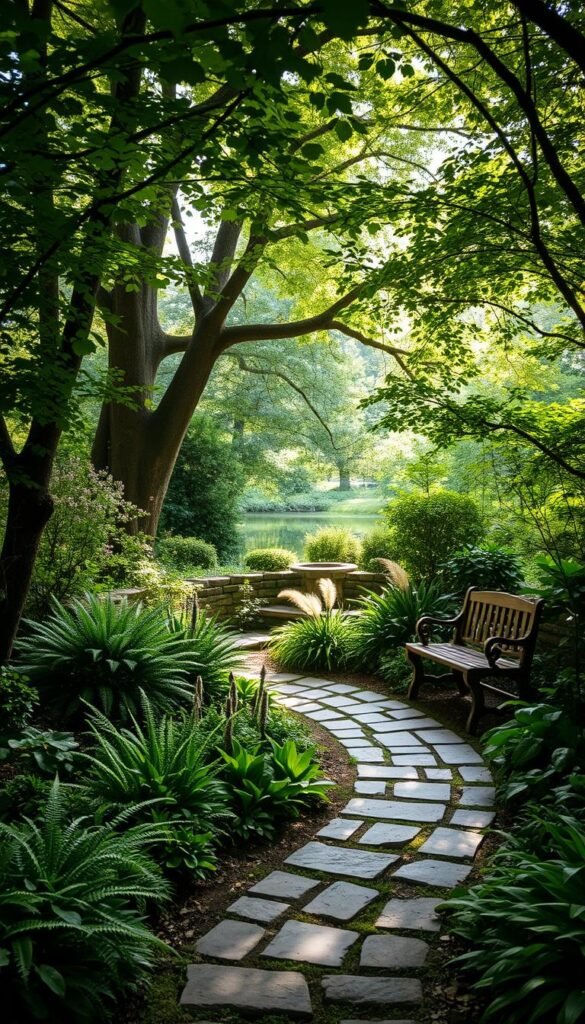
Transform underused corners into cozy nooks with smart design choices. Strategic placement of seating and decor turns dim areas into inviting escapes. Let’s explore how to craft intimate zones that feel both secluded and connected to nature.
Creating Intimate Patio and Seating Areas
Jeff Epping’s elevated patio design shows how levels create immersion. Three steps down to seating areas make you feel surrounded by greenery. A central stone path guides visitors toward borrowed views, expanding your space visually.
Position benches where trees frame natural sightlines. Use tall ferns or hydrangeas as living walls. This defines zones without blocking airflow. Curved stone edges soften hardscape elements, blending them with plantings.
Incorporating Water Features and Decorative Accents
Rebecca Sweet suggests using blue ceramic pots or mirrored panels to amplify light. A small fountain adds soothing sounds while reflecting foliage patterns. Try these combos:
| Element | Effect | Placement Tip |
|---|---|---|
| Birdbath | Attracts wildlife | Near flowering shrubs |
| Antique sprinkler | Adds vintage charm | Beside hosta clusters |
| Glass garden balls | Refracts light | Under tree canopies |
Discover creative gardening ideas using colorful mosaics or weather-resistant sculptures. Group accents in odd numbers for balanced displays. A single statement piece works well in compact spaces.
Incorporating Hardscape Elements in Your Shade Garden
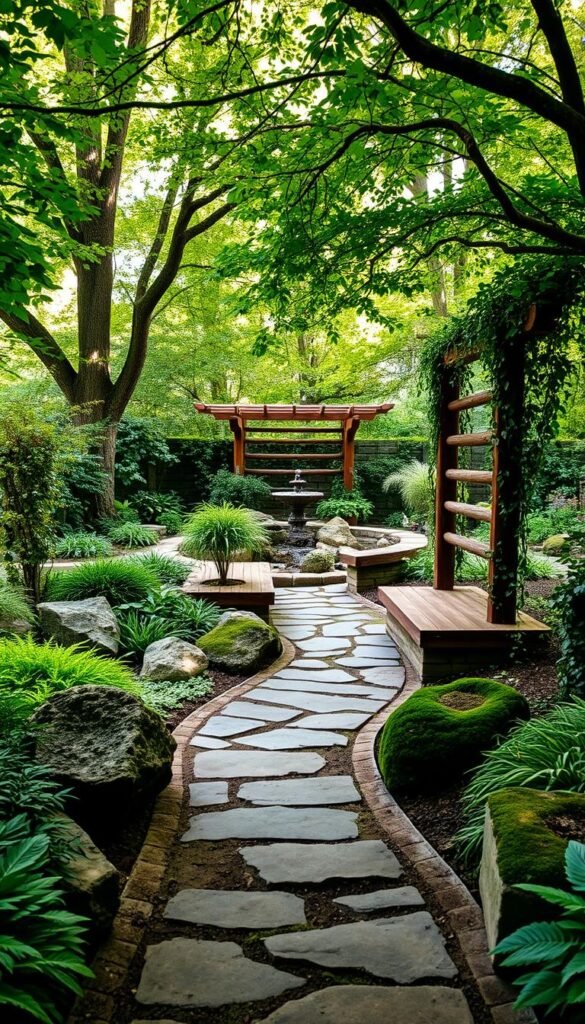
Stone and wood become your allies where sunlight falters. Hardscape features solve practical challenges while adding polished structure to leafy environments. They anchor plantings and create usable zones that thrive without constant upkeep.
Building Pathways, Patios, and Raised Areas
Natural stone pathways guide exploration through your space. Flagstone slabs with creeping thyme between joints soften edges. For partial shade areas, pair bluestone with Japanese forest grass – its arching stems cascade over edges beautifully.
Raised beds tackle drainage issues in full shade zones. Stacked slate walls elevate hostas and ferns, improving soil airflow. Landscape designer Jeff Epping recommends repeating materials: “Rustic blocks used for patios and walls create visual harmony.”
Replace struggling turf with functional hardscaping. A circular gravel patio under trees becomes an instant seating area. Add lighting along paths using:
- Recessed step lights
- Solar-powered post lanterns
- Overhead string bulbs
Thesedesign tipsextend your garden’s usability into evening hours.
Drainage planning prevents waterlogging. Slope paved surfaces 1-2% away from structures. Permeable materials like crushed granite allow moisture absorption in partial sun areas. Consistent textures and colors keep focus on your Japanese forest grass and other botanical stars.
Maintenance Tips for a Thriving Shade Garden
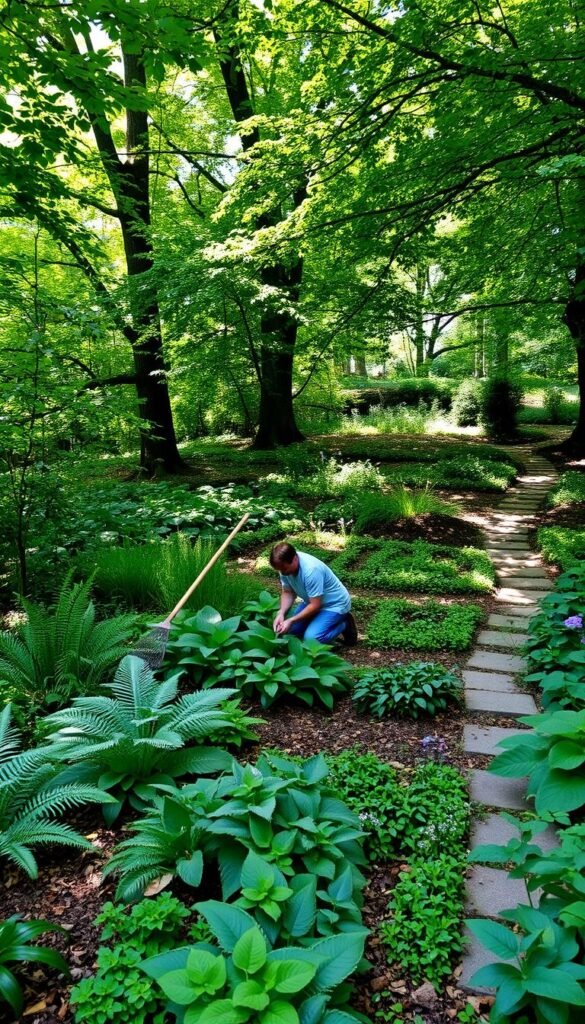
Efficient upkeep transforms shaded areas into vibrant, low-maintenance sanctuaries. While these spaces often demand less work than sunny plots, understanding their unique rhythms ensures your foliage stays healthy year-round.
Watering, Fertilization, and Seasonal Plant Care
Under tree canopies, roots compete fiercely for moisture. Check soil weekly by pushing your finger 2 inches deep. If dry, water slowly to penetrate competing root systems. Morning irrigation reduces evaporation and fungal risks.
Most plants here thrive with minimal feeding. A spring layer of compost often provides enough nutrients. As horticulturist Janet Loughrey advises: “Over-fertilizing encourages weak growth that pests love.” Remove spent flowers to redirect energy into leaf production.
Seasonal shifts dictate key tasks. Clear fallen leaves in autumn to prevent mold, but leave some as winter mulch. Discover seasonal care routines that apply to shaded spaces too.
Adapting to Changing Conditions and Eco-Friendly Practices
As trees mature, their expanding canopies create deeper shade. Replace sun-loving understory plants with varieties like foamflower that tolerate darkness. Let fallen foliage decompose naturally – it enriches soil and shelters beneficial insects.
Embrace self-seeding natives like wild ginger to fill gaps effortlessly. For pest control, introduce ladybugs instead of chemicals. These strategies align with container gardening principles for low-light areas.
Adjust your approach annually. What thrived in partial sun five years ago might now need relocation. Observe, adapt, and let nature guide your evolving oasis.
Final Thoughts on Cultivating Your Serene Oasis
Your outdoor sanctuary begins with observation. Notice how light dances through branches or where moss naturally carpets the ground. These details guide your journey toward a space that feels both intentional and effortless.
Embrace textures and colors that whisper rather than shout. A single variegated plant can illuminate dim corners, while clustered ferns create depth. Remember: successful spaces evolve. Start small, then refine as you learn your area’s unique rhythm.
Even compact zones shine with clever solutions. For inspiration on maximizing every inch, explore vertical planters or reflective surfaces. They add function without overwhelming delicate ecosystems.
Let nature collaborate in your design. Fallen leaves become mulch, while shifting sunlight reveals new focal points. Your retreat isn’t static—it’s a living canvas that rewards patience and adaptability. Now pour your favorite drink, settle into that bench, and savor the calm you’ve cultivated.

